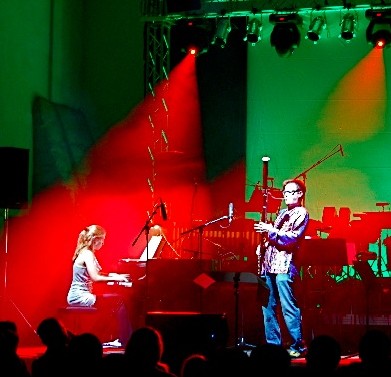
M odified #3 is the modification and expansion of sound... a future of what can be done electronically with timbre... a full composition from one sound, manipulated and transformed into many sounds.”
— Gene Pritsker.
T he three solo pieces by Till Körber, Christof Cech, and David Lang each push the boundaries of bassoon playing in their own unique way.”P lease have a listen to ‘modified’, a wonderful CD by bassoonist Matthias Kronsteiner and collaborators Lisa Preimesberger (bass clarinet), Thomas Frey (flute), Ernst Weissensteiner (double bass), Philipp Sageder (voice), and Gene Pritsker (electronics; percussion), a CD to be released this coming Tuesday by CCR/Naxos. The disc opens with two movements from Heitor Villa-Lobos’s Bachianas brasilieras No. 6, W392, but the rest of the recording consists of new compositions by Till Körber, Christof Cech, Gernot Wolfgang, David Lang, Johannes Berauer, and Gene Pritsker.
— Matthias Kronsteiner.
[40-sec clip, Matthias Kronsteiner, Heitor Villa-Lobos, ‘Bachianas brasilieras No. 6, W392 – Ária (chôro)’; (track 1), 2011, 1.3MB MP3]
V illa-Lobos’s entry into the Parisian art world took place in 1922, immediately before Modern Art Week in São Paulo. The composer was invited to a lunch in the studio of the painter Tarsila do Amaral where he met up with, among others, the poet, painter, and film-maker Jean Cocteau. After the lunch, the artists became engrossed in a lively conversation which drifted into a discussion on the art of musical improvisation. Villa-Lobos... sat down [at do Amaral’s grand piano] to improvise. Cocteau, known for his boutades and his playful behavior, sat underneath the piano on the ground, ‘so I can hear better.’ At the end of Villa-Lobos’s improvisation, however, Cocteau returned to his chair and launched a ferocious attack on what he had heard: in his opinion, the music presented by the composer was not futuristic at all, probably no more than an emulation of the styles of Debussy and Ravel. Villa-Lobos immediately began furiously improvising more. Cocteau, though, remained intransigent, questioning this time whether true improvisation could be made in this way, played-to-order. The two artists began a heated ‘discussion’ and thought about exchanging blows. Some years later, David Bowie took up improvising impromptu lyrics and melodies in this manner, the grandeur and menace of ‘Heroes’, and all.”
— Paulo Renato Guérios, Museu Nacional/UFRJ, 2006.
[30-sec clip, Matthias Kronsteiner, David Lang, ‘Press Release’; (track 6), 2011, 1.2MB MP3]
T he brilliant pieces that make up this disc are each virtuosic in their own way. Agogic emphases at downward leaps and fast passages with wide-ranging excursions spanning the entire range of the instrument provide lots of dramatic interest. One senses an affectionate irony in writing things that make the bassoon do extremely dangerous leaps, with a high probability of hard landings. The cumulative effect of these essentially asserts the concreteness and everydayness of [virtuosic] bassoon-playing, denying its mystical, expressive side as the performer navigates these hazards. That the attempt is ultimately successful, and that it is carried off with panache, takes it beyond the everyday, though, and turns it into something redemptive or transcendent (something like playing Czerny at-tempo).
T here are lyrical, genuinely lovely passages and other spiky, vehement ones. The quality is incontestable throughout, compositions and performances of excellent artistry. To this are added the promised merits of inventiveness of ‘futuristic’ timbres—both in the individual [analog and digital] sounds, and in the formulas and orchestrations, which at times assemble themselves into pantheistic sonic agglomerations where the Great Unity cannot be separated into constituent parts (esp. the Pritsker piece).
T he minimalism that is evident in several of the works—notably the Lang piece—is like looking at a portrait for many tens of minutes, to understand and enjoy its charm. Beyond a certain limit, it becomes a form of Zen meditation or hypnosis. Whatever it is, it is enjoyable and valuable.
C omposers Concordance Records (link below) production values are excellent. The studio recording and engineering processes have nicely captured the all of the expressive bassoonism here—athletic, taut key-presses; sharp attacks; emphatic articulations—particularly on Kronsteiner’s playing in the pulsatile Lang and Cech pieces. Never too much key-noise or reed and breath sibilants... just enough so that you feel like you are there, as if up-close in a live performance.
T he intimacy of this Studio Weinberg recording is captivating. There are beginnings, middles, and endings in these pieces—they are not entirely linear, and they always have intriguing complexities, but they are not severe ones that diminish their accessibility or joy. This is no priceless ceramic vase or objet d’art or museum gallery! The pieces on this CD invite you to friend them and use them.
- Kronsteiner M. modified_music for bassoon. (CCR, 2011.)
- Composers Concordance Records
- Matthias Kronsteiner website
- Johannes Berauer on MySpace
- David Lang website
- Gene Pritsker website
- Gernot Wolfgang website
- Tonstudio Weinberg, Prager Bundesstraße B 310, A-4292 Kefermarkt
- Heitor Villa-Lobos free scores for Bachianas brasilieras at IMSLP.org [not public-domain in U.S.]
- Heitor Villa-Lobos website
- Appleby D. Heitor Villa-Lobos: A Life. Scarecrow, 2002.
- Béhague G. Villa-Lobos: The Search for Brazil’s Musical Soul. Univ Texas, 1994.
- Peppercorn L. Villa-Lobos, the Music: An Analysis of His Style. Stefan De Haan, tr. Kahn & Averill, 1991.
- Tarasti E. Heitor Villa-Lobos: The Life and Works. McFarland, 2000.
- Wright S. Villa-Lobos. Oxford and New York: Oxford Univ, 1992.
[Matthias Kronsteiner, Christof Cech, ‘New Waves’, 2010]
S ome years ago, I was interviewing for a quant job on Wall Street and, as one of the provocations to challenge the poise of his interviewee, the head of the firm abruptly asked whether I had ever been with a mulata brasiliera. I did not laugh. I replied, No, I was happily married, but I had been with Bachianas Brasilieras Nos. 1 through 6 and found them deeply intriguing and satisfying. He did not laugh. I do not know if it was a good enough answer.”
— DSM.
No comments:
Post a Comment